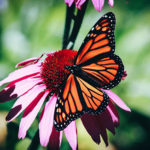David Yarrow, probably the most easily recognized names in wildlife photography, believes in what Andy Warhol said: “My favorite color is white and my favorite color is black.” In this interview with GMAX Studios, he shares some of his secrets:
Proximity and Ground Level Perspective
When it comes to wildlife photography Yarrow likes to shoot at close proximity and with ground level perspective. The main concern with this approach is how to keep yourself safe at all times. To keep himself out of harm’s way, many of his shots are made using remote triggers. The camera is pre-focused and hidden out of the path of the animal. The idea is that the animal shouldn’t be aware of the camera until it’s about a foot and a half away from it.
Locations
Many wildlife photographers don’t have a specific animal in mind when they pick a location. They choose the destination and then the animal, while ideally it should be the other way around. For example, Amboseli is the best place in the world to photograph elephants, according to Yarrow.

Know what you want to photograph and then find the best destination to photograph it.
Timing
The time of the year is of critical importance to wildlife photography. For shooting his images in Amboseli, for instance, Yarrow prefers skies that are moody–an almost impending doom look. This is something that can only be achieved in October.

When it comes to wildlife photography, timing is crucial.
Lens Choice
“Wildlife photographers, many of them, use telephotos far too much. If you’re going to be photographing a beautiful woman you’re never going to shoot her with a 400mm lens or even a 200 or 300. You’d shoot her with a standard lens or a wide angle, and it should be the same with animals.”

The lens sees both ways.
Yarrow borrows from Robert Capa when he says, “If your images aren’t good enough, you’re probably not close enough.” He also mentions Ansel Adams, saying the lens looks both ways—maybe not necessarily when you’re using a 400mm lens, but it’s certainly true when you’re using a shorter one.
Line of Sight
When you’re photographing an animal, if your line of sight is higher than the animal, it immediately suggests that the encounter is artificial and that you’re higher up.

The photographer was close enough to take a selfie of himself in the bear’s eyes.
Access
With the kind of photography that Yarrow does, 95 percent of the work is about getting into the right position so that he can then use his skills to make an image. That means a huge amount of work—paid and otherwise—to research and arrange the logistics. Pressing the shutter release is just about 5 percent of the job.

Most of the work is getting everything sorted out to be in the right position.
Yarrow’s inspirational black and white images are some of the best examples of wildlife photography. His work is routinely featured in print publications, and he also sells limited edition fine art prints.
Like This Article?
Don't Miss The Next One!
Join over 100,000 photographers of all experience levels who receive our free photography tips and articles to stay current:






Leave a Reply